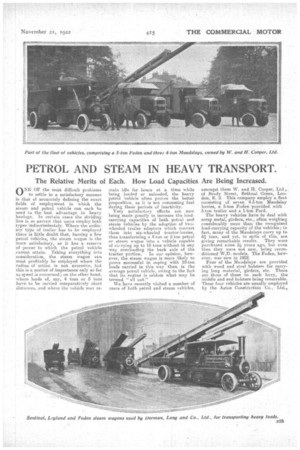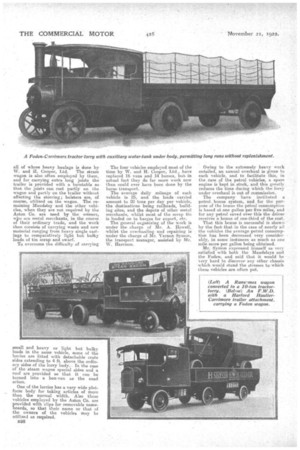PETROL AND STEAM IN HEAVY TRANSPORT.
Page 9

Page 10

If you've noticed an error in this article please click here to report it so we can fix it.
The Relative Merits of Each. How Load Capacities Are Being Increased.
ONE OF the nnist difficult problems to settle in a satisfactory manner is that of accurately defining the exact fields of employment in which the steam and petrol vehicle can each be used to the best advantage in heavy 'haulage. In certain cases the dividing line is so narrow that users employ both types indiscriminately. Where the ordinary type. of trailer has to he employed there is little doubt that, barring a few petrol Vehicles, the steam wagon is the more satisfactory, as it has a reserve of power to which the Petrol vehicle .cannot attain. Taking everything into 'consideration, the steam wagon can most profitably be ernployed where the radius of action is nob excessive, but this is a matter of importance only so far as speed is concerned ; on the other hand, where loads of, say, 4 tons or 5 toms have,, to be carried comparatively short distances, and where the vehicle max re main idle for hours at a time while being loaded or unloaded, the heavy petrol 'vehicle often proves the better proposition, as it is mit consuming fuel during these periods of inactivity. Very satisfactory efforts are now being made greatly to increase the loadcarrying capacities of both petrol and steam vehicles by the adoption of twowheeled trailer adapters which convert them into six-wheeled tractor-lorries, thus transforming a 4-ton or 5-ton petrol or steam wagon into a vehicle capable of carrying up to 10 tons without M any way overloading the back axle of the. tractor portion. In our opinion, however, the.steam wagon is more likely to prove successful in coping with 10-ton loads carried in this way than, is the average petrol' Vehicle, owing to the fact that its engine is seldom what may be termed 'all out,"
We have recently visited a number of users of both petrol and steam vehicles,
amongst them W. and H. Cooper, Ltd.,. of Brady Street, Bethnal Green, London, E. 2. This company employ a fleet consisting of seven 4-5-ton Maudslay lorries, a 5-ton Foden provided with 3-ton trailer and a 1-ton Ford.
The heavy vehicles have to deal with scrap metal, girders' etc., often weighiog considerably more than the recognized. load-carrying capacity of the vehicles; in fact, many of the Maudslays carry up to 6S.-' tuns, and yet, in spite of this, are giving remarkable results. They were purchased some 2i years ago, but even then they were not new, 'being reconditioned•W.D, models. The Foden, however, was new in 1922.
Four of the Mandslays are provided with wood and steel bolsters for Carrying long material, girders, etc. There are three of these to each lorry, the middle and end bolsters being removable. These four vehicles ate usually employed by the Aston Construction Co., Ltd.,
all of whose heavy haulage is done by W. and H. Cooper, Ltd. The steam wagon is also often employed by them, and for carrying extra long joists the trailer is provided with a turntable so that the joists can rest partly on the wagon and partly an the trailer without affecting the steering; bolsters are, of course, utilized on the wagon. The remaining Mandelay and the other vehicles, when they are not required by the Aston -Co. are used by the owners, 1.31-10 are metal merchants, in the course of their ordinary trade, and the work then consists of carrying waste and new material ranging from heavy single castingS to comparatively light but bulky loads of tin scrap and swan.
To overcome the difficulty of carrying
small and heavy or light but bulky loads in the same vehicle, some of the lorries are fitted with detachable crate sides extending to 4 ft. above the ordinary sides of the lorry body. • In the case of the steam wagon gpeciai sides and a roof are provided so that it can be turned into a box-van as the need arises.
One of the lorries has a very wide platform body for taking articles of more than the normal width. Also those vehicles employed by the Aston Co. are .provided with clips for removable nameboards, so that their name or that of the owners of the vehicles may be utilized as required.
B26 The four vehicles employed most of the time by W. and H. Cooper, Ltd., have replaced 1.& vans and 14 horses, limb in actual fact they do far more work now than could ever have been done by the horse transport.
The average daily mileage of each vehicle is 25, and the loads carried amount to 20 tons per day per vehicle, the destinations being railheads, building sites, and the depots of -other metal merchants, whilst most of the scrap tin is loaded on to barges for export, etc.
The, general organizing of the work is under the charge of Mr. A. Howell, whilst the overhauling and repairing is nnder the charge of Mr. Vernon S3-mon, the transport manager, assisted by Mr. NV. Harrison. Owing to the extremely heavy Work entailed, an annual overhaul is given to each vehicle, and to facilitate this, in the case of the petrol vehicles, a spare engine is kept in stock, and this greatly reduces the time during which the lorry under overhaul is out of commission.
The company have instituted a petrol, bonus system,. and for the purpose of the bonus the petrol consumption is based at one gallon per five miles, and for any petrol saved over this the driver receives a bonus of one-third of the cost.
That this bonus is successful is shown by the fact that in the case of nearly ail the vehicles the average petrol consumption has been decreased very considerably, in some instances as much as one mile more per gallon being obtained. Mr. Symon expressed himself as very satisfied with both the Maudslays and the Foden, and said that it would he very hard to discover any other chassis which would stand the stresses to which these vehicles are often pat.






























